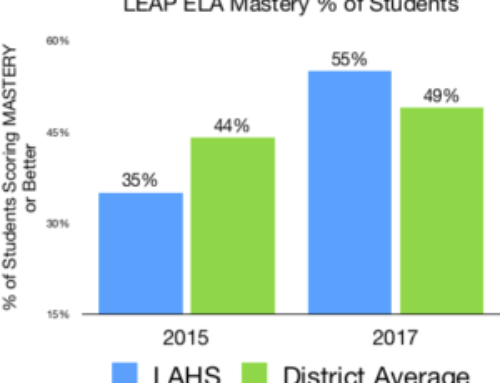
Diana Tang
Measuring and Improving Student Engagement: An Education Leader’s Perspective
Interview with Diana Tang
by Isaac D. Van Wesep
________________
Diana Tang is on a mission to expand the way teachers assess and improve their connections with – and impact on – their students.
As Senior Managing Director for Teacher Leadership Development at Teach For America Houston, Diana is focused on developing and implementing strategies to foster teachers as leaders in their classrooms and their organizations. That means a lot of different things, but one thing that is getting a lot of Diana’s attention right now is the topic of student engagement and other non-academic measures of student growth and achievement.
I sat down with Diana last week to talk about the importance of student engagement on student achievement (both academically and non-academically), and how she and her organization Teach For America Houston are working to understand engagement and improve it in the schools where their Corps Members teach.
IDVW: why do you think student engagement and other non academic factors are important to teaching and learning?
DT: Measuring engagement offers teachers different kinds of information, which can help bolster the academic work and overall student success. And so that opportunity to process the information is ultimately going to lead towards deeper internalization of the actual academic content. That kind of engagement in the classroom is a lever or a pathway to impact academic growth.
We know that teachers who make a more holistic impact on students – the teachers whom we have seen to most effectively impact kids – have also had a positive effect on non-academic factors like engagement. So, for example, they are helping to create other opportunities on campus that don’t currently exist, whether that’s something from creating after-school programs or helping to funnel more scholarship funding to the school, or helping to build student confidence and connectedness to teachers, students, and staff at the school. This kind of trust-building and relationship-building is especially important if that trust between student and adults at the school has been broken, which can be true for the vast majority of students in certain schools.
And so I think we can both see it as a pathway towards academic success, but we also recognize that in order for students to have success in the long term, whether that’s in a college or career, they need access to additional opportunities and a continued practice in non-academic skills.
The other reason we look towards student engagement and other “non-academic” outcomes is because part of our organization’s mission is educational equity. Engagement in the classroom, with the school, and the community is one way to improve outcomes for students. And it’s a place where there is a known gap between socio-economic groups. So we are focused on engagement for that reason, too.
IDVW: And how do you measure engagement?
DT: We measure it in two ways: through student surveys and then the other way is through observing the behaviors related to student engagement. So, for example, we’re in a classroom observing one of our Corps Members, seeing whether students are being given multiple opportunities to think and talk either individually or with groups of students.
IDVW: I read a study of students who had missed a lot of school and were in danger of dropping out. The study found that the students and parents both cared deeply about education and wanted to do well in school and go on to college. However, the students said none of the grown-ups at the school cared about them beyond their test score, and that none of their peers cared about them either. Does this ring true to you?
DT: Yes. I’ve seen similar studies. One of the local nonprofits that we work with focuses specifically on working with students who have come into contact with the juvenile justice system. One of their big studies that they shared with our Corps Members is that whether or not students believe that they have a caring adult at the school is one of the leading indicators of whether they will drop out of school, miss school, or come into contact with the juvenile justice system. And there is a cure for that problem. We have found that it could be a teacher, a counselor, or an administrator, but whoever makes the connection with the student, that connection is actually very crucial.
IDVW: So what do those grownups do to show the students that they care?
DT: That’s a good question. There is a lot of ways, and again they span both in-class and out-of-class actions.
In the classroom, students need to see that you believe that they can learn, that you are giving them multiple opportunities be successful, and that you are willing to actually focus on them individually to make sure they succeed. That individual attention is powerful. I think that many students are surprised when their teacher focuses on them one-on-one. The kids are like ‘oh my teacher cares because she actually sits down next to me and helps me through the work.’ I hear this from my Corps Members. And my Corps Members tell me that when they asked students ‘don’t all your teachers do this?’ the answer was ‘no.’ So a lot of the time, teachers and other grown-ups can be just much more passive in the interactions.
Then there is the other piece, which is ‘does my teacher care about me as a person?’ When a student feels like the grown-ups in the school have a sense of what’s going on outside of the classroom, and even outside of the school space, then that is even more powerful.
IDVW: How do you know if a student feels this way, or not?
DT: A lot of times like students who feel like their teachers care a lot about them will say that they know their family members, they know my sibling, they know my parents or my grandparents.
And then I think the like third tier of things that we’ve seen with our teachers that have the most long-lasting impact of things like that they have served as a mentor after even after that student has left the classroom. We surveyed high school students about this, and they have shared that, especially with some of the teachers in our program, they’re like ‘this is the teacher that sticks with me even after I’ve left her classroom.’ and ‘This is the person that I call when I’m like figuring out which colleges that I’m applying to.’
So ideally we are seeing our Corps Members connected, and really excited about making sure that they learn in the classroom, getting to know them as an individual or like their world around them. And then finally, uh, in some cases actually serving as a long-term mentor in their education and personal career
IDVW: How do you to train teachers to excel at this kind of engagement?
DT: Engagement is connected to our regional Teach For America Houston vision. We see it as three different pillars. One big pillar is what we call our Ecosystem of Support. That’s about building relationships with students, families and potentially serving as long-term mentors. The other pillar is around the academic space: helping to create many opportunities for students to engage, and fostering curiosity and inquiry. And the final pillar – that are still building now – is what we call Critical Consciousness. Critical Consciousness is about helping students to understand and make a connection to the real world. Because we’re working in underrepresented communities, it is important for us to help them to see and understand the systemic nature of some of the barriers or problems that they may be running up against, so that they have the tools to make good decisions and overcome those barriers.
IDVW: And all these Pillars work together?
DT: Yes. At a high level, the pillars make the content very relevant and help students see the power that they have to actually change the space around them. We want students to understand that yes, I am learning this math content so I can pass this test. But it will also help me get to college. AND, most importantly of all, this math is actually a really powerful tool that will allow me to understand our world, to question our world, and to actually change the things that I want to change.
IDVW: Can one teacher make a difference?
DT: It is possible. I think when that has been successful, that teacher or a small group of teachers is highly skilled at being able to influence and motivate and engage other adults on campus because they cannot do it alone. In those cases, Corps Members from Teach For America Houston have had really strong peer relationships and have created a really strong parent engagement that may not have existed before. Or if they’ve been able to motivate and influence other administrators.
But this is really about teacher leadership. And we do work hard to create teachers as leaders. As an organization, where is isn’t necessarily our place to be partnering at that level with the school, and where we are a 13-person management team with Corps Members spread across the entire city, we have to empower teachers to be a force for change where possible and appropriate.
On that leadership front, in Houston, we have a broad base of Teach For America alumni. Many of them are still working in a school. They might be right in their tenth year on a campus as a teacher or there might be that assistant principal or actual principal at the school. In those cases, we can sometimes coordinate at a higher level around student engagement practices. But we also recognize we’re working based off of district needs.
IDVW: Have your engagement surveys or observations told you anything, yet?
DT: Well, as I said I think there is a lot of anecdotal evidence and common wisdom around the importance of engagement. It makes sense, right? But the question for us is more around ‘do we know how to measure it?’ and once we are sure of that, then we can start to figure out how to be systematic and predictive about how to improve engagement and what we think the impact will be on academic and other measures of student achievement.
We really have just started to utilize student surveys and some of our observational data. We want to first make sure that those data measurements are accurate and consistent across all of our coaches so that we get a couple of years with the student survey data in a couple years worth of observational data of classroom engagement. There are times where we run correlative like data regressions there. I think with more data we will feel more confident that we’ll be able to correlate those things. We’ve done that very broadly with like classrooms that are highly engaged. I think probably in a year or two we should be able to connect to see if there’s a correlation between engagement survey data, observational data, and student achievement. I think that’s what the intention of doing this in mass across the organization as well as that we’ll have better tools and then, therefore, better, a better statistical analysis we could be doing.
IDVW: That is exciting.
DT: Yes it is!
IDVW: Well, you have given us a lot of food for thought. Thank you for giving us a look inside how an organizational leader thinks about student engagement.
DT: You are welcome! Any time.




